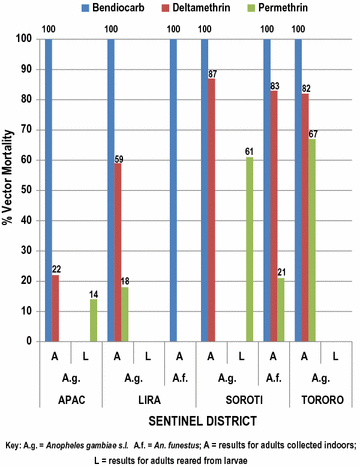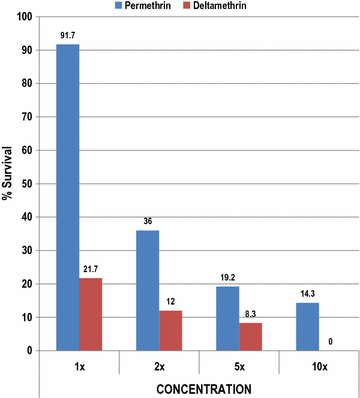Insecticide resistance status of the malaria mosquitoes: Anopheles gambiae and Anopheles funestus in eastern and northern Uganda
- PMID: 29625585
- PMCID: PMC5889576
- DOI: 10.1186/s12936-018-2293-6
Insecticide resistance status of the malaria mosquitoes: Anopheles gambiae and Anopheles funestus in eastern and northern Uganda
Abstract
Background: Uganda's malaria burden includes the sixth highest number of annual deaths in Africa (10,500) with approximately 16 million cases (2013) and the entire population at risk. The President's Malaria Initiative has been supporting the malaria control interventions of indoor residual spraying (IRS) and distribution of long-lasting insecticidal nets (LLIN) in Uganda since 2007. These interventions are threatened by emerging and spreading insecticide resistance, known to exist in Ugandan malaria vectors. Pyrethroid insecticides have been used in agriculture since the early 1990s and in IRS programmes from the mid-2000s until 2010. A universal LLIN coverage campaign was executed in 2013-2014, distributing pyrethroid-treated LLINs throughout the country. This study investigated insecticide susceptibility, intensity, and oxidase detoxification in Anopheles gambiae sensu lato and Anopheles funestus to permethrin and deltamethrin in four eastern Ugandan sites.
Methods: The susceptibility status of An. gambiae and An. funestus to bendiocarb, permethrin and deltamethrin was determined using the CDC (Centers for Disease Control and Prevention) bottle bioassay. Presence of oxidative enzyme detoxification mechanisms were determined by pre-exposing mosquitoes to piperonyl butoxide followed with exposure to discriminating doses of deltamethrin- and permethrin-coated CDC bottles. Resistance intensity was investigated using serial dosages of 1×, 2×, 5× and 10× the diagnostic dose and scored at 30 min to determine the magnitude of resistance to both of these LLIN pyrethroids. Testing occurred in the Northern and Eastern Regions of Uganda.
Results: Anopheles gambiae and An. funestus were fully susceptible to bendiocarb where tested. Anopheles gambiae resistance to deltamethrin and permethrin was observed in all four study sites. Anopheles funestus was resistant to deltamethrin and permethrin in Soroti. Oxidative resistance mechanisms were found in An. gambiae conferring pyrethroid resistance in Lira and Apac. 14.3% of An. gambiae from Tororo survived exposure of 10× concentrations of permethrin.
Conclusions: Both An. gambiae and An. funestus are resistant to pyrethroids but fully susceptible to bendiocarb at all sites. Susceptibility monitoring guided the Ministry of Health's decision to rotate between IRS insecticide classes. Intensity bioassay results may indicate encroaching control failure of pyrethroid-treated LLINs and should inform decision-makers when choosing LLINs for the country.
Keywords: Anopheles funestus; Anopheles gambiae; Insecticide resistance; Intensity bioassay; Oxidase; Uganda.
Figures





References
-
- WHO. World malaria report. Geneva: World Health Organization; 2015. http://www.who.int/malaria/publications/world-malaria-report-2015/report.... Accessed 5 May 2016.
-
- WHO. Global plan for insecticide resistance management in malaria vectors (GPIRM). Geneva: World Health Organization; 2012. http://www.who.int/malaria/publications/atoz/gpirm/en/. Accessed 9 Nov 2015.
-
- USAID. Report on national malaria vector susceptibility to public health insecticides in Uganda, September 02–16, 2013.
MeSH terms
Substances
LinkOut - more resources
Full Text Sources
Other Literature Sources
Molecular Biology Databases

